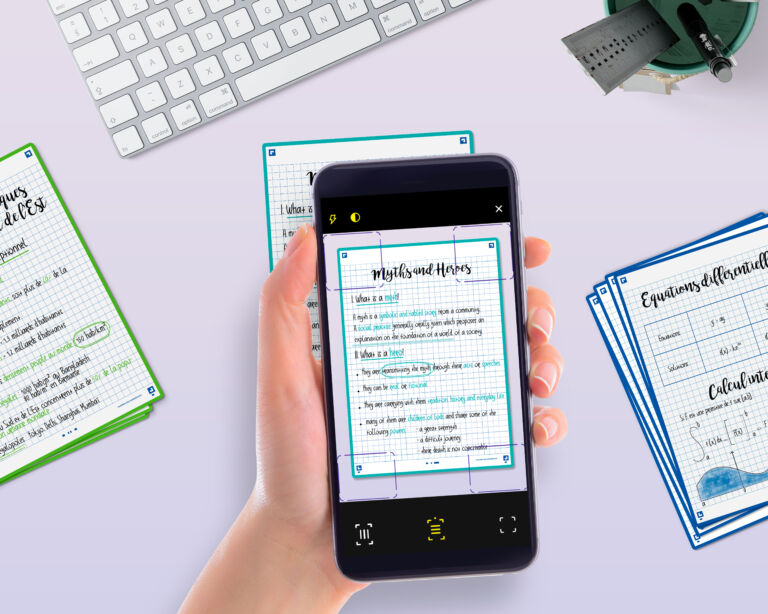
The blurting method for memorising: what is it?
Throughout the year, memorising efficiently is an important skill. That’s because the more efficient you are at learning, the more time you’ll be able to devote to your other interests (sport, hobbies, socialising, etc.). You’ve probably already tried different methods, with varying degrees of success…
But have you ever tried the blurting method?
Used by many high school and university students for its simplicity and overall effectiveness, the “blurting” method, also known as the “blank sheet ” method, consists of reading the key information from a lesson and then “blurting everything out” by writing everything you can remember down on paper or a whiteboard.
There are 6 main steps to using this technique effectively:
1) Understand
Choose a chapter & read it, trying to really understand it.
While reading, feel free to annotate your notes to add elements that will help you grasp all the key concepts and create associations between the different concepts mentioned.
For more efficiency, don’t hesitate to break your chapter down into different sub-chapters and read them one by one.
2) Say
This is the optional step in this method. The method is seen as effective even without it. However, it can enhance memorisation, especially if you’re an auditory learner.
If this is the case, feel free to read your chapter out loud and rephrase it orally.
3) Cover
After reading your chapter, cover up what you’ve read or close your notebook. It’s important that you don’t look at your notes again during the next step. So be honest with yourself and detach yourself from your lecture.
4) Write
Take a blank sheet of paper and a pen and set a timer. The length of the timer should depend on the length of the content you’ve just read. For a standard-sized chapter, set it for 5 minutes. For a whole lesson, you will need to increase the time.
During this time, think back to the chapter you’ve just read and write down everything you remember in as much detail as possible.
Be careful: don’t put any aesthetic constraints on yourself. The aim here is to write down the parts of the chapter you were able to memorise on paper and not to produce pretty notes. You can choose to write down the information you’ve retained in a linear way (traditional note-taking) or in the form of a mind map if you are comfortable with this technique, which allows you to visually highlight the links between information.
But why a timer? The “pressure” of the timer can act as a real booster. It’s more challenging for you to have a timeline to follow. Moreover, without a timer, the risk is that you won’t know when to stop and you’ll tire yourself out trying to recall something for a long time when that’s not the aim of the method.
5) Check
When the timer reaches zero, go back to the chapter you originally read and compare it with the information you wrote on your sheet or whiteboard.
When comparing the 2, look for:
- Information you transcribed correctly: Leave it as it is on your sheet of paper,
- Information you couldn’t remember: Add it with a pencil or in a different colour than the one you used previously,
- Errors you may have made: Correct them with a pencil or in the same colour as for the things you couldn’t remember.
You’ll be able to tell straight away which parts you know well and those you don’t know yet using the different coloured pens.
Ask yourself why you couldn’t remember certain information. Is it because you didn’t understand it?
6) Repeat
Once you’ve identified the information you can and can’t remember, start the exercise again from scratch:
- Read your chapter again focusing on the information you didn’t quite understand last time,
- Hide your chapter,
- Take a new blank sheet of paper and try to write down all the information you can remember,
- Check the information.
Repeat as many times as necessary until you have mastered your entire course.
Why does the Blurting Method work?
Like any technique, it has its advantages and disadvantages. But with this method, the advantages outweigh the disadvantages!
1) It’s an active revision method.
This means that you’re an active participant in your own learning process, since you must:
- Challenge your knowledge: by writing it out by hand on a sheet of paper without the help of your notes,
- Test yourself: by checking what’s missing or where you’ve made a mistake, you have a vision of what you have and haven’t mastered.
2) You write by hand, so you memorise
Handwriting stimulates many areas in your brain. That’s right, as you write, your brain sends your hand the information needed to make the movements to form the words to be written. This boosts your memory, as scientists Pam A. Mueller and Daniel Oppenheimer have proven.
3) You repeat the learning process several times
The strength of this method also lies in the fact that you must repeat the technique several times until you’ve mastered all the information in your chapter. Repetition is an essential component of memorisation because it prevents you from forgetting. The more regularly you review your lesson, the less likely you are to forget it, as you will reactivate your memories of it. You can add a study reminder with SCRIBZEE to schedule your different work sessions.
4) It’s a simple method to use
This technique is relatively easy to use as all you need is paper or a whiteboard and different coloured pens: supplies that you probably already have at home.
The Blurting technique is therefore ideal for learning your lessons, preparing for a supervised assignment or an exam. Although it requires a lot of concentration on your part, it’s very simple to set up and you’ll see results very quickly when using it. So, when are you going to start?




